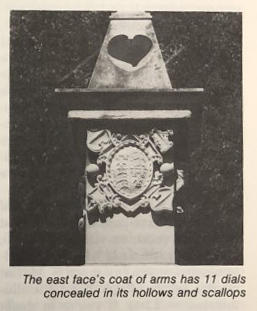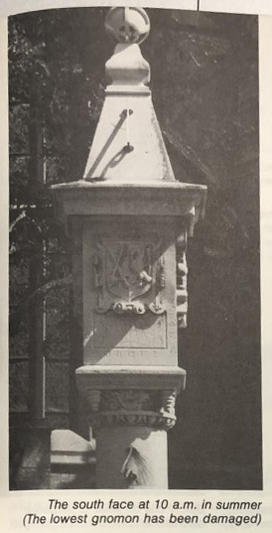With some students back on campus this spring, soon McCosh courtyard will be filled with students enjoying the sunny spring weather at a social distance. What they and many alumni of the University may not know, though, are the origins of the Mather Sundial located in the courtyard — or that it even is a sundial!
Modeled after one that has stood since 1579 in the front quadrangle of Oxford’s Corpus Christi College, this sundial, though weathered over the years, is fully functional. Phillip Pattenden helped conduct a historical restoration of it in 1976, and in the June 15, 1981, issue of PAW, he explained how to read the sundial and the significance behind much of the architecture.
Reading Mather’s Sundial
By Philip Pattenden
(From the June 15, 1981, issue of PAW)
Philip Pattenden, a fellow of Peterhouse, Cambridge, and an old member of Corpus Christi College, Oxford, conducted the historical restoration of the Oxford sundial in 1976.

Though the stone of the Princeton copy has badly eroded over the years, at the time it was erected in McCosh Courtyard it faithfully replicated all 27 sundials on the original. At the top of both is a heraldic pelican (the symbol of Corpus Christi) standing on a globe, which rests on a pyramid with four dials, to the north, south, east, and west, the last two being hollowed out of the stone. Beneath a cornice bearing four inscriptions, including the date 1581, when the Oxford pillar was completed, there is a cubical stone block with the arms of Corpus Christi College’s founder, of its chief benefactor, of the Tudors, and of Oxford University. Each piece of heraldry contains another sundial, the time being read on the Princeton copy from the shadow of a metal rod set below the relief work of the arms.
Finally there comes the cylindrical shaft of the pillar with a curious sundial on the south side. This one is particularly unusual in that it is marked out on a curved surface, which makes it difficult to read. The remaining 18 dials are even harder to read, or for that matter to see, being set into the hollows and scallops around the arms, 11 on the east side and 7 on the west side. Moreover, when Mather had his copy made, these had deteriorated on the original and so were not accurately reproduced on the Princeton pillar. (They were later restored on the Oxford pillar.)
The 20-foot column rests on a base of five octagonal steps, the top one of which is raised to form a seat. On its sides are inscribed some verses, the dedication inscription, and the arms of Princeton University. Once the exclusive preserve of seniors, the steps are now a favorite site for outdoor precepts. But despite their springtime intimacy with the steps, few students have ever known how to decipher the Mather sundial’s many timepieces, silent mysteries of an earlier age.
It is a fallacy that sundials give only a rough approximation of time. They are as accurate as their calibration and as the observation of the person reading them. Long after watches and clocks came into popular use during the 18th century, sundials were employed for setting and checking them. In fact, until about 1900, one dial with a shadow cast by a gnomon made of fine wire was used by French railwaymen to set their watches.
We often forget that on watch and clocks we use first Mean Time, an average of the variations in the length of the solar day throughout the year, and secondly time zones (Eastern, Central, etc.) to make it convenient to conduct business and travel within a fairly wide area without changing our watches for every few miles we may venture east or west of our starting meridian. A sundial, on the other hand, gives accurate time for its locale and neither averages nor compromises what it measures according to our conventions.
The easiest dial to read on the Mather column faces south, toward McCosh Hall, from the pyramid beneath the pelican. It is read counterclockwise, with the morning hours on the left-hand side, noon at the bottom, where six o’clock would be on a watch, and afternoon on the right. Readers who want to check their watches by the dial should modify time indicated by the shadow according to the table below. To the time given on the dial, add or subtract the number of minutes shown to arrive at Eastern Standard Time. This table, which is suitable only for a sundial at Princeton, takes into account the normal period of Daylight-Saving Time (given as May to October).
Table shows number of minutes to add to or subtract from time on dial
Day of Month | Jan. Feb. Mar. Apr. | May June July Aug. Sep. Oct. | Nov. Dec. |
1st 15th | +2 +12 +11 +3 +8 +13 +8 -1 | +56 +56 +62 +65 +59 +48 +55 +59 +65 +63 +54 +45 | -18 -12 -17 -6 |
On the south side of the shaft, underneath the curved sundial to the right-hand side, is a table for finding time by the light of the moon, which some readers might like to try out for themselves. The table consists of four tables, headed by a symbol of the crescent moons and the letters D D H M. Though most of the inscriptions in the last two columns have faded, the table is reproduced here.
Start by estimating the number of days which have passed since the last new moon (new, no visible disc = 0; first quarter, whole of left-hand disc illuminated = 7½; full moon = 15; last quarter, whole of right-hand disc illuminated = 22½). If you’re in doubt about the moon’s age, consult a calendar or newspaper. Having found the age, locate it in the first or second column of the table and then add the correction of hours (H) and minutes (M) to the time that the moon’s shadow gives on any of the sundials. The result will be roughly Eastern Standard Time; add one more hour during Daylight-Saving Time.
If the moons does not disappear behind a cloud while calculations are in progress, the time may be found accurately, but there is still a double hazard not present when the Mather dial was installed — trees have grown and artificial lights have proliferated, so some care may now be needed to find the shadow. A great deal also depends on getting the age of the moon correct, since, as can be seen from the table, an error of a day can make a difference as much as 48 minutes.

Consequently, the Princeton copy lacks some of the Gregorian alterations. Nonetheless, it is still possible to make sense of the figures given for the Julian Calendar, and the missing pieces of the table can now be supplied, so that the mathematical puzzle can still be read. When the Princeton sundial was made, the inscriptions were incised into the stone, so that they would take centuries to vanish completely. But because of the effects of weather and atmospheric pollution they do need recutting every few decades.
Table for telling time from moon
Days | Days | Hours | Mins |
1 | 16 | 0 | 48 |












No responses yet